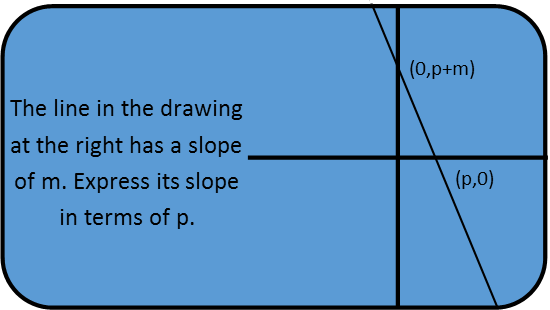Math Made Easy: Problem of the Day 37
Todayís problem is straight out of the SAT. Letís take a look at it.

It really just requires a bit of juggling. First, we need to recognize that slope equals rise over run, and we can find the slope of a line from any two points on the line with the following equation:

And since the slope of this line IS m, we can just plug the points into that equation. It doesnít matter which one we call point 1 and which we call point 2, as long as weíre consistent, and the y coordinates go on top while the x coordinates go on bottom. Once we do that, we solve. I see that m is both sides of the equation, and to solve for the slope in terms of p, I need to get m on its lonesome on one side of the equation, with everything else on the other. Since itís in a fraction with p, the first thing Iím going to do is break up that fraction. I see I have a constant in part of it since p/p is just one, and I write it as such.

I then move the 1 to the m side of the equation by adding 1 to both sides. After that, I divide both sides by m so that my mís and pís are no longer all mixed up.

I at least have all my variables separated, but mís not all alone yet. I still have work to do. Just as I broke up the original fraction, Iím going to break up my new fraction, and I again see I have 1 in the form of m/m, so I write it as such.

Then I move the 1 BACK over to the side of the equation with p by subtracting it from both sides of the equation. Well, look at that, m is on its lonesome. BUT, itís on the bottom of a fraction. Thatís no good, but itís easily resolved by taking the reciprocal of both sides of the equation. Before I can do that, I need to combine the p-side into one fraction. I find a common denominator by multiplying 1 by p/p, and add them.

Note that I recognize I could factor that negative sign out of both fractions resulting in a negative fraction but 1 and p being added in the numerator rather than subtracted. Once I have both sides expressed as fractions, I just flip everything (the reciprocal). Lo and behold, after a little bit of creative juggling, weíre done. We have the slope, m, expressed in terms of the variable p.

|



